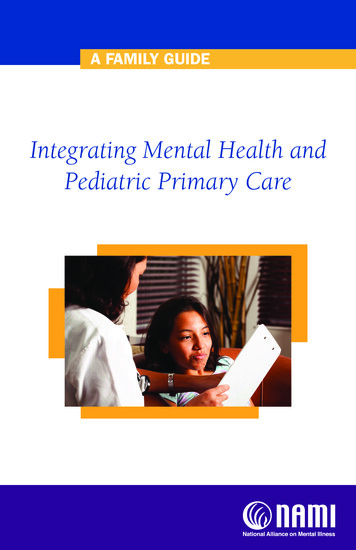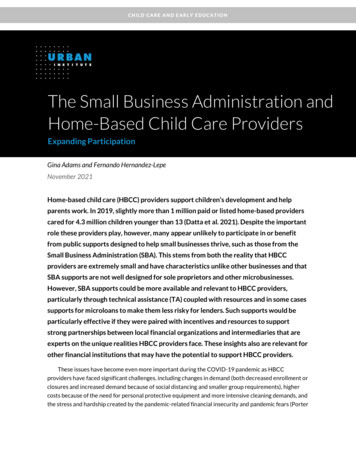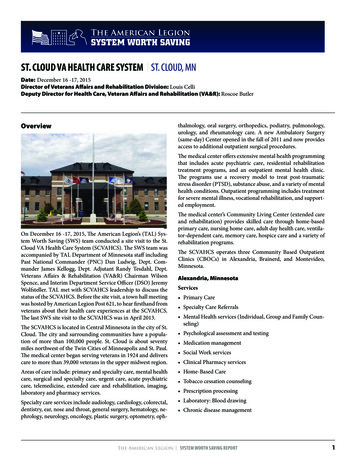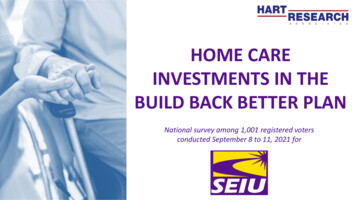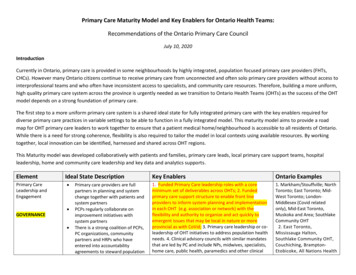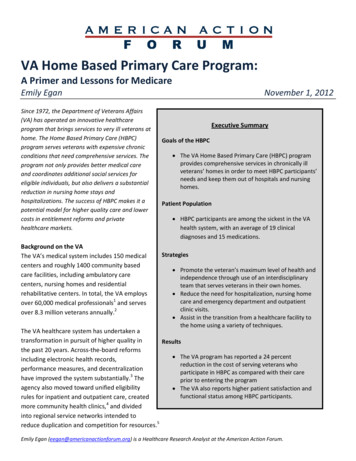
Transcription
VA Home Based Primary Care Program:A Primer and Lessons for MedicareEmily EganSince 1972, the Department of Veterans Affairs(VA) has operated an innovative healthcareprogram that brings services to very ill veterans athome. The Home Based Primary Care (HBPC)program serves veterans with expensive chronicconditions that need comprehensive services. Theprogram not only provides better medical careand coordinates additional social services foreligible individuals, but also delivers a substantialreduction in nursing home stays andhospitalizations. The success of HBPC makes it apotential model for higher quality care and lowercosts in entitlement reforms and privatehealthcare markets.Background on the VAThe VA’s medical system includes 150 medicalcenters and roughly 1400 community basedcare facilities, including ambulatory carecenters, nursing homes and residentialrehabilitative centers. In total, the VA employsover 60,000 medical professionals1 and servesover 8.3 million veterans annually.2November 1, 2012Executive SummaryGoals of the HBPC The VA Home Based Primary Care (HBPC) programprovides comprehensive services in chronically illveterans’ homes in order to meet HBPC participants’needs and keep them out of hospitals and nursinghomes.Patient Population HBPC participants are among the sickest in the VAhealth system, with an average of 19 clinicaldiagnoses and 15 medications.Strategies Promote the veteran’s maximum level of health andindependence through use of an interdisciplinaryteam that serves veterans in their own homes. Reduce the need for hospitalization, nursing homecare and emergency department and outpatientclinic visits. Assist in the transition from a healthcare facility tothe home using a variety of techniques.The VA healthcare system has undertaken atransformation in pursuit of higher quality inResultsthe past 20 years. Across-the-board reforms The VA program has reported a 24 percentincluding electronic health records,reduction in the cost of serving veterans whoperformance measures, and decentralizationparticipate in HBPC as compared with their carehave improved the system substantially.3 Theprior to entering the programagency also moved toward unified eligibility The VA also reports higher patient satisfaction andfunctional status among HBPC participants.rules for inpatient and outpatient care, created4more community health clinics, and dividedinto regional service networks intended toreduce duplication and competition for resources.5Emily Egan (eegan@americanactionforum.org) is a Healthcare Research Analyst at the American Action Forum.
The VA health system reforms have led to higher satisfaction among patients and staff, as well as measuredimprovements in care. A study in the New England Journal of Medicine compared quality measures such asvaccinations, screening, and treatment for both chronic and acute conditions across inpatient and outpatientsettings for Medicare and the VA. Whereas the VA’s performance had previously lagged behind Medicare, theresults demonstrated that its system-wide reforms enabled the VA to outperform Medicare on every measure bythe late 1990s.6VA Home Based Primary Care Program (HBPC)The VA began using comprehensive home care in 1972 with 6 demonstration sites within the Hospital Based HomeCare Program. In 1995, the name changed to the Home Based Primary Care program, and it was expanded duringthe reforms of the 1990s.7Operated by the VA Office of Geriatrics and Extended Care, the HBPC program serves veterans with disablingchronic conditions for whom periodic doctor visits are insufficient. Participants are selected for the program basedon clinical diagnoses, the risk of expensive hospitalizations and nursing home stays and proximity to a VA hospitalwhere a HBPC team is based. Prior to the HBPC program, these veterans would have received care in outpatientsettings and, for the very ill, and likely cycled in and out of hospitals and nursing homes. The HBPC program isdesigned to instead provide comprehensive care in the home setting and prevent additional conditions orcomplications that would otherwise necessitate further expensive treatment.Care teams are comprised of a physician, medical directors, nurses, social workers, dieticians, psychologists,pharmacists and rehabilitative therapists. The care team provides integrated care and coordinates with eachother, the patient and (if applicable) the patient’s family caregivers. The care team also provides referrals toadditional services as needed to help the veteran take advantage of a variety of resources in and outside of the VA.The program is not designed for people who need daily intervention or long-term care, as patients receive anaverage of 3 visits per month.Currently there are 116 sites serving over 12,000 veterans annually.8 Notably, there is neither a requirement thatprogram participants be “homebound” nor that they need skilled rehabilitative care, both of which are required byMedicare for a patient to receive home health benefits. HBPC’s focus on home-based care: (a) is generally lessexpensive than treatment in institutional settings; (b) gives providers a better picture of the patient’s environmentand any potentially dangerous situations; (c) allows them to form relationships with family caregivers; and (d)reduces missed appointments which can lead to complications and additional costs.A brief statistical portrait of the Home Based Primary Care population includes: The HBPC population is comprised of veterans with an average age of 76.5 years old.9 96 percent of HBPC patients are male.10 Nearly half of the HBPC population has functional limitations and cannot perform two or more activities ofdaily living (ADLs)11 without assistance.12www.AmericanActionForum.org
HBPC participants have an average of 19.4 diagnoses and take 15 prescription medications regularly.13Common diagnoses and their prevalence in the HBPC population are listed below in Table 1.Table 1: Common Diagnoses and the Percentage of HBPC Participants Exhibiting Them14Heart Disease: 72%Diabetes: 48%Depression: 44%Heart Failure: 35%Dementia: 33%Cancer: 29%Substance Abuse: 29%Schizophrenia: 20%Evidence on HBPC ResultsSeveral studies have examined the HBPC program’s effectiveness, with particular emphasis paid to patientfunctional status, hospital readmissions, nursing home stays and cost.One study, commissioned by the Department of Veterans Affairs Cooperative Studies Program and published in theJournal of the American Medical Association (JAMA) in 2000, compared quality of life, functional status, and costbetween a treatment group of patients enrolled in the HPBC program versus a control group using traditional VAservices. The study found that the HBPC program achieved significantly higher scores for “health related quality-oflife” among the subset of terminally ill patients, higher patient and caregiver satisfaction for all treatment patients,and comparable functional statuses between the treatment and control group. This study found that over the oneyear duration, the treatment group’s aggregate costs were 12 percent higher than the control group.15Subsequent research found improvement in outcomes as well as cost-savings. A study conducted by the VA in2002, compared hospitalizations, nursing home days of care and cost for over 11,000 HBPC patients for 6 monthsbefore entering the program against those measures in the first 6 months of enrollment. Hospitalizations,measured in hospital days of care, dropped 62 percent and nursing home days of care dropped by 88 percent. Afteraccounting for the cost of the program, the average cost reduction was 24 percent.16Figure 1: Average Annual Cost of Care Prior to and During HPBC Participation1740,00024% 0Before HBPCDuring HBPCwww.AmericanActionForum.org
A comparable analysis conducted in 2007 showed very similar results on hospital admissions: the study reported a69 percent reduction in hospital inpatient days of care, as shown in Figure 2, as well as a 27 percent reduction inadmissions.18 Thus, over time these studies indicate the HBPC program’s success in allowing patients to remain intheir home and spend less time in the hospital or nursing home, as well as demonstrating the cost effectivenessrelative to traditional VA care.Figure 2: Hospital Inpatient Days per 10,000 VA Days1970605069% Reduction403020100Before HBPCDuring HBPCHow does HBPC Differ From Medicare’s Home Health Benefit?Medicare also provides in-home medical care to an elderly population that includes those with many complexchronic conditions and functional limitations, but the benefit is quite different HBPC. Medicare’s home healthbenefit is chiefly medical in nature, often rehabilitative, and is rarely fully-coordinated with the patient’s other careproviders. Medicare home health visits are also structured as short-term episodes, whereas the HBPC program isintended to provide care as long as it is appropriate for the patient. In addition, Medicare-provided home health isonly available to homebound beneficiaries, whereas HBPC is able to serve a broader population of high-costchronically ill patients.Because patients with complex chronic conditions served by Medicare as well as those dually eligible for Medicaidand Medicare have similar care needs to the VA’s HBPC enrollees, it raises the possibility that the use of an HBPCmodeled program could similarly reduce hospital and nursing home stays within entitlement programs. Thesuccessful long-term provision of chronic care management services to currently high-cost patients would enableMedicare to prevent them from cycling in and out of hospitals and nursing homes, and has the potential forsignificant cost-savings.ConclusionThe Home Based Primary Care program has achieved meaningful improvement in a number of important criteria,not the least of which include: patient outcomes and satisfaction, care coordination and program cost. Forwww.AmericanActionForum.org
policymakers seeking similar improvements in the Medicare or Medicaid programs, or private insurers looking toimprove their benefits and managed care plans, the HBPC model is worth considering due to the following factors: HBPC participants share many similarities high-cost chronically ill beneficiaries served by other programs orcommercial insurance.HBPC fully utilizes strategies that are attempted but not fully implemented elsewhere includingcomprehensive service delivery in the home, coordination of services provided by multi-disciplinary careteams, and interoperable electronic health records.HBPC’s focus on home-based care has been documented to substantially reduce the utilization of expensiveinstitutional facilities, which currently contribute to the unsustainable pace of healthcare cost increases.The American Action Forum is a forward-looking policy institute. The Forum produces real-time,fact-based, innovative policy analysis and solutions for policymakers and the public alike. Ourmission is to promote common sense, innovative and solution-based policies that will reformgovernment, challenge outdated assumptions and create a smaller, smarter government.The Healthcare Policy team at the American Action Forum produces timely, quality economicanalyses on the effects of federal healthcare policies. Through meticulous research, statisticalmodeling, and careful reasoning, the healthcare team develops policies which will improve healthcare quality and patient choice but also reduce excessive health care spending. These analysesinform policymakers, press, and the general public about the nuances of the American healthcaresystem.www.AmericanActionForum.org
ReferencesCongressional Budget Office “The Health Care System for Veterans: An Interim Report” December 2007. bofiles/ftpdocs/88xx/doc8892/12-21-va healthcare.pdf2“About VHA” The United States Department of Veterans Affairs website. Available: http://www.va.gov/health/aboutVHA.asp3Perlin, Jonathan. “Transformation of the US Veterans Health Administration” Health Economics, Policy and Law (2006)4United States. Department of Veterans Affairs. VA History in Brief. Web. ves/docs/history in brief.pdf pg. 305Perlin, Jonathan. “Transformation of the US Veterans Health Administration” Health Economics, Policy and Law (2006)6Jah, Ashish K., Jonathan B. Perlin, Kenneth W. Kizer, and R. Adams Dudley. Effect of the Transformation of the Veterans AffairsHealth Care System on the Quality of Care. Publication. New England Journal of Medicine, May 29, 2003. Msa021899#t article7Beales JL, Edes T. “Veteran's Affairs Home Based Primary Care.” Clin Geriatr Med. 2009 Feb;25(1):149-54, viii-ix.Available: , Dayna et. al. “Care of the Veteran at Home.” Home Healthcare Nurse. Volume 25 (5). May 2007.9Beales JL, Edes T. “Veteran's Affairs Home Based Primary Care.” Clin Geriatr Med. 2009 Feb;25(1):149-54, viii-ix.Available: s JL, Edes T. “Veteran's Affairs Home Based Primary Care.” Clin Geriatr Med. 2009 Feb;25(1):149-54, viii-ix.Available: ities of daily living include eating, bathing, dressing, toileting and the like.12Beales JL, Edes T. “Veteran's Affairs Home Based Primary Care.” Clin Geriatr Med. 2009 Feb;25(1):149-54, viii-ix.Available: s JL, Edes T. “Veteran's Affairs Home Based Primary Care.” Clin Geriatr Med. 2009 Feb;25(1):149-54, viii-ix.Available: r, Dayna et. al. “Care of the Veteran at Home.” Home Healthcare Nurse. Volume 25 (5). May 2007.15Hughes, Susan et al. “Effectiveness of Team-Managed Home-Based Primary Care.” Journal of the American MedicalAssociation. Vol 284 No. 22. December 13, 2000.16Beales JL, Edes T. “Veteran's Affairs Home Based Primary Care.” Clin Geriatr Med. 2009 Feb;25(1):149-54, viii-ix.Available: s JL, Edes T. “Veteran's Affairs Home Based Primary Care.” Clin Geriatr Med. 2009 Feb;25(1):149-54, viii-ix.Available: r, Dayna et. al. “Care of the Veteran at Home.” Home Healthcare Nurse. Volume 25 (5). May 2007.19Cooper, Dayna et. al. “Care of the Veteran at Home.” Home Healthcare Nurse. Volume 25 (5). May 2007.1www.AmericanActionForum.org
The VA began using comprehensive home care in 1972 with 6 demonstration sites within the Hospital Based Home Care Program. In 1995, the name changed to the Home Based Primary Care program, and it .
